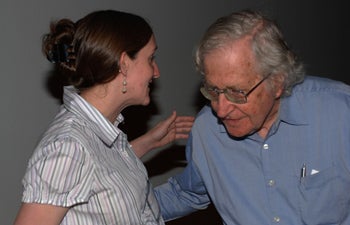A Tribute to Words
One of the founders of modern linguistics Noam Chomsky recalled in the 1950s when a prominent senior linguist told him flat out that he would no longer conduct analyses but only collect data.
The senior linguist told Chomsky that since computers were on the horizon and the method of analyses were more or less understood, there was no point in carrying out computations by hand. Soon, data would be entered into computers and answers would be instantly available, the senior linguist reasoned.
“Now there’s a field called corpus linguistics, which is essentially the same thing,” Chomsky said, drawing laughter from the audience at the Museum of Contemporary Art (MOCA) in Los Angeles, who knew that corpus linguistics runs counter to Chomsky’s belief in conducting studies under highly controlled laboratory settings.
Corpus linguistics is the study of language as expressed in samples or “real world” text that is largely derived by an automotive process. Chomsky argues that real language is riddled with performance-related errors requiring careful analyses.
Chomsky discussed the changing landscape of linguistics over the past half century during the May 5-7 conference in honor of the work of Jean-Roger Vergnaud, Andrew W. Mellon Professor of Humanities and professor of linguistics in USC Dornsife, who died Jan. 31, 2011, at age 65 after being diagnosed with leukemia in spring 2009.
“This workshop was planned long before Jean-Roger Vergnaud’s unfortunate death,” James Higginbotham, Distinguished Professor of Philosophy and Linguistics and Linda MacDonald Hilf Chair in Philosophy in USC Dornsife, said while introducing Chomsky.

James Higginbotham, Distinguished Professor of Philosophy and Linguistics and Linda MacDonald Hilf Chair in Philosophy in USC Dornsife, introduces Noam Chomsky during the conference held at the Museum of Contemporary Art (MOCA) in Los Angeles.
Higginbotham had been Vergnaud’s close friend and colleague since the early ’80s when they met at the Massachusetts Institute of Technology, where Higginbotham taught and Vergnaud earned his Ph.D. and often returned as a visiting scholar.
“Jean-Roger was once described to me as having a gossamer mind,” Higginbotham later said during the event. “After having met him I understood. He was relentlessly abstract. And that was one of the great virtues that he brought to our subject in my opinion.”
Titled, “Parallel Domains: Locality in Syntax/Phonology and the Representation of Constituency,” the workshop centered around Vergnaud’s challenge of common ways of thinking about grammatical relationships represented within tree structures. A tree structure is a graphic representing the hierarchical nature of a structure; the classic representation resembles a family tree chart. Vergnaud believed linguists should test whether a more abstract representation of constituent structure in terms of graph theory can adequately represent grammatical relations in a sentence. He believed that such mathematical tools could reveal the common computational principles that govern the relationship between the basic syntactic units in a sentence and those that govern the articulatory and rhythmical components of language.
The conference was organized by graduate students in USC Dornsife’s Department of Linguistics and led by Katy McKinney-Bock, a fourth-year graduate student of theoretical syntax. Vergnaud was her academic adviser.

Katy McKinney-Bock, Jean-Roger Vergnaud’s fourth-year graduate student of theoretical syntax and main organizer of the event, whispers something into Noam Chomsky’s ear during the conference.
Chomsky; Louis Goldstein, professor of linguistics in USC Dornsife; Joost Kremers of the University of Göttingen in Germany; and Dominique Sportiche, professor of linguistics at UCLA, were among the participants. Vergnaud’s colleagues and former students traveled from as far as the Abu Dhabi Emirate, Lebanon and Korea to attend.
“It was a very successful conference, both intellectually and socially,” reflected Maria Luisa Zubizarreta, professor of linguistics in USC Dornsife and Vergnaud’s wife of 28 years. “We had colleagues and students from many different parts of the country, as well as from Europe, Asia and the Middle East.
“Prominent scholars from the ’70s and ’80s were there who had not crossed paths in a very long time,” she said. “The talks were very thought-provoking, in the spirit of Jean-Roger’s own work. We were of course delighted to have Noam Chomsky there to give a deeply significant talk that touched on issues that ranged from the basics of ‘doing science’ to more technical issues related to syntactic theory and explanatory power.
“It was also a very emotional conference. We could see that in the presentations that paid tribute to Jean-Roger as a colleague, mentor and friend.”

Karine Megerdoomian, Jean-Roger Vergnaud’s graduate student who worked with Vergnaud from 1993 to 2002, reminisces about her former professor during the conference, with Vergnaud’s former graduate student Tommi Leung, currently a professor at the University of Dubai, on the same panel.
Such was the case with Karine Megerdoomian, Vergnaud’s former graduate student who is now a lead artificial intelligence engineer at the MITRE Corporation in Virginia, a nonprofit managing research for the Department of Defense. She spoke during the “Panel in Honor of Jean-Roger Vergnaud.”
“The Latin word to ‘educate’ is to draw out and I think that’s how Jean-Roger Vergnaud taught,” Megerdoomian said. “He didn’t lecture in the traditional sense. He didn’t tell you what he thought the answer was. I think he believed that students had the answers and he led us to bring it out from within.”
Vergnaud taught her to cut through the jargon. Megerdoomian recalled once when she was discussing event structures with Vergnaud.
“He said what does that [event structure] mean?” she recounted. “He pushed me to explain. I finally replied that it was a verb phrase. ‘Then why don’t you just call it a verb phrase?’ he told me.
“We didn’t learn things from Jean-Roger. What we learned was a way of thought. We learned to question, to think outside of the box. And most important for me at least was to believe in my intuition, even if it goes against the mainstream.”